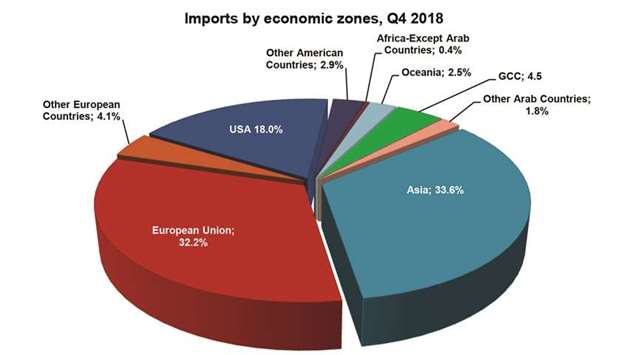Faster expansion in exports, especially to Asia, and weakened imports helped Qatar register a 42% year-on-year growth in trade surplus to QR50.86bn during the fourth quarter (Q4) of 2018, according to official estimates.
For the full year 2018, trade surplus swelled about 40% to QR191.44bn, according to figures released by the Planning and Statistics Authority.
In Q4, Qatar’s total exports (of domestic goods and re-exports) were QR79.7bn, which grew 16.4% on a yearly basis. Imports declined 11.6% to QR28.8bn.
Asia was the principal destination of Qatar’s exports and the first origin of Qatar’s imports, representing 81.8% and 33.6% respectively; European Union or EU (9.9% and 32.2%) and the Gulf Co-operation Council or GCC (3.8% and 1.8%).
Exports to South Korea were at QR14.4bn (18.1% of total exports); Japan QR13.7bn (17.2%); and China QR10.1bn (12.6%). Imports from China were at QR3.6bn (12.5% of total imports), India QR1.6bn (5.5%) and Japan QR0.9bn (3%).
Trade balance with Asia amounted to QR55.7bn, while total trade (exports plus imports) was QR75bn during the review period.
Exports to Asia were dominated by liquefied natural gas (LNG), crude oil, condensates, naphtha, propane, butane, polyethylene, urea, aluminium alloys, bars and rods of iron or non-alloy steel, ether derivatives, vinyl chloride, methanol, and unwrought aluminium (not alloyed).
Imports from Asia comprised principally vehicles, telephones sets, mobile, jewellery of gold, rice, portable digital automatic data processing machines, self-propelled railway, or tramway coaches, ethylene, steel structures, and live sheep pure-bred breeding animals.
The EU accounted for 9.7% of Qatar’s exports and 32.2% of imports. Italy was the major destination, reporting exports of QR1.8bn (2.3% of total exports), the UK at QR1.4bn (1.7%) and Spain at QR0.8bn (1.1%).
Imports from the UK amounted to QR2.4bn (8.3% of total), Germany QR2bn (7%) and Italy QR1.1bn (3.9%). In Q4, 2018, trade balance with the bloc showed a deficit of QR1.6bn, while total trade amounted to QR17bn.
Exports to the EU were mainly LNG, fuel for jet-plane engine polyethylene, halogenated olefins, helium, natural gasoline melamine, sulphuric acid, aluminium alloys, unwrought aluminium (not alloyed), sodium hydroxide mixed hexanes, and mixed alkyl benzenes and mixed alkyl naphthalene.
Imports from EU included principally vehicles, parts of airplanes or helicopters, line pipe, longitudinally submerged arc welded, intake air filters for internal combustion engines, iron ores and concentrates, medical solutions, and reaction initiators.
The GCC accounted for 3.9% of Qatar’s exports and 4.5% of Qatar’s imports. Trade balance with the region saw a surplus of QR1.8bn, while the total trade was QR4.4bn.
Exports to the GCC comprised principally, natural gas, LNG, sheet piling of iron and steel whether or not drilled, sulphuric acid, diesel for engines, natural gasoline, unwrought aluminium not alloyed, ether derivatives, bars and rods of iron or non-alloy steel, polyethylene, bars and rods of iron or no alloy steel, and hexanes.
Imports included pebbles, gravel, broken or crushed stone, iron ores and concentrates, electric cables, ethylene, parts for electrical transformers, static converter, other varnish dissolved in an aqueous medium, panels for a voltage, residues of pet oils, make-up preparations, tubes pipes and hoses, of polymers of ethylene, powder puffs and pads for the application of cosmetics or toilet preparations.
In Q4, 2018, other surplus was registered in the trade balance with non-Arab African countries of QR0.8bn (1.6%). A deficit of QR4bn was registered in the trade balance with the US, QR1.1bn with other European countries (not in the EU), QR0.5bn with other American countries and QR0.3bn with Oceania countries.

Graph 22

